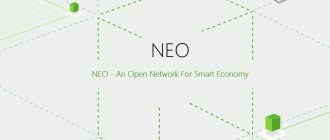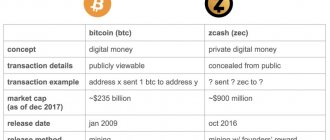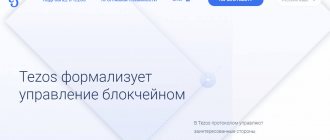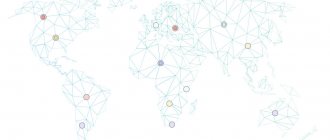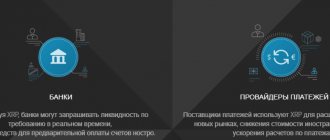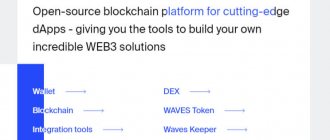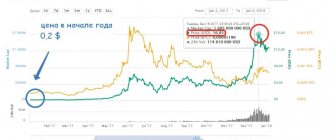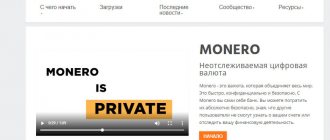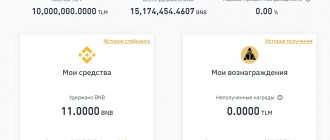Fantom – a distributed network based on DAG, including the use of parallel data chains, new methods for increasing scalability and a high-performance virtual machine. Provides secure and efficient execution of smart contracts. The internal token is FTM. Before the launch of the main network, it is hosted on the Ethereum blockchain platform and is an ERC-20 standard token. After the Main Net is deployed, FTM will be transferred to its own blockchain and will be considered a cryptocurrency.
On June 11, 2019, the Binance exchange (binance.com) added the Fantom (FTM) token for trading in FTM/USDT, FTM/BTC, FTM/BNB pairs.
Information
Fantom cryptocurrency performance as of June 12, 2022:
| Name | Fantom |
| Ticker | FTM |
| Capitalization | 68 952 624 $ |
| Well | 0,032 $ |
| Current issue | 2 061 263 236 FTM |
| Maximum emission | 2 061 263 236 FTM |
| Website | https://fantom.foundation/ |
| WhitePaper | https://fantom.foundation/fantom-research-papers/ |
| Source | https://github.com/Fantom-Foundation |
| Blockchain Explorer | https://etherscan.io/token/0x4e15361fd6b4bb609fa63c81a2be19d873717870; https://bscscan.com/token/0xad29abb318791d579433d831ed122afeaf29dcfe; |
| Social media | https://twitter.com/FantomFDN; https://t.me/Fantom_English; https://www.reddit.com/r/FantomFoundation/; https://chat.fantom.network/ |
| Cryptocurrency exchanges | Binance, OKEx, KuCoin, BitMax, etc. |
| Launch year | 2018 |
| CEO | Ahn Byung Ik |
| Main Net | 2019 |
FANTOM DAG aims to establish a complete IT infrastructure for cities.
Several service providers can combine into a “smart” network, offering customers scalable solutions and high-speed data transfer. If progress continues as it is now, then by 2022 there will be a total of at least 90 billion IoT devices in all major cities. Each device sends information, and this data needs to be stored as securely and conveniently as possible, using applications and smart contracts. Smart cities are not the only direction of FANTOM. Attention is also paid to the following areas:
- smart House;
- public utilities;
- health protection;
- education;
- road traffic;
- resource management;
- ecology.
In each of these areas, blockchain solutions can be implemented to facilitate and speed up data transfer. In the end, both business owners and ordinary people will benefit.
OKB (OKB)
The OKB token updated its all-time high on February 22 at $23.80; the coin has been declining since then. The token fell in price by more than 30% to $15.80.
Despite the fall, OKB ranks 66th in the ranking by market capitalization.
However, technical indicators are turning down. In particular, the RSI has crossed 70, and the stochastic is forming a bearish cross.
OKB is trading just above the support level of $14.50, formed by the 0.5 Fibonacci retracement. However, further decline could lead to a fall to the 0.618 Fibonacci retracement at $12.30.
OKB chart from TradingView
Read BeInCrypto's latest technical analysis on Bitcoin (BTC) here.
What is FTM
The network is based on a directed acyclic graph (DAG) model, mainly intended for the operation of smart contracts. FTM is the first cryptocurrency project to introduce DAG into its ecosystem. Time will tell how effective this approach will be. For consensus, the Lachesis protocol is built into a separate OPERA blockchain. Thanks to the OPERA chain, which contains most of the nodes, transactions become faster, to the point of being processed instantly. As the network grows, so does the number of nodes, but the design used in FTM makes the blockchain infinitely scalable. It turns out that an increase in the number of users does not slow down, but speeds up the blockchain.
This can be useful in almost any industry where scalability is important. For example, financial institutions, e-commerce, logistics and supply chain, telecommunications. In addition, the Fantom cryptocurrency may be of interest to developers of decentralized applications.
How advanced is the project?
The actual Fantom architecture is divided into three layers.
Lower
Also called the OPERA base layer, it is responsible for creating events and maintaining consensus across all nodes via the Lachesis protocol. Transactions are confirmed through the use of a direct acyclic graph (DAG), which allows nodes to process transactions asynchronously.
Similar to a blockchain, transactions are stored on each node on the network, although the data is not required to be stored across all nodes. To verify transactions, a second type of node is used, called a witness node. These witnesses check the validity of all nodes in the network. They rely on Proof of Stake to select validators.
Average level
The protocol is called OPERA Ware Layer. This level operates to perform functions such as issuing payments, rewards and writing “Data History”.
Top level
Called the OPERA application layer, it provides public APIs for dApps to use in the middle tier. One aspect of the note is what Fantom calls the “History of History.”
Although Ethereum has a limited ability to track past transactions, Fantom solves this problem by using Story Data, which allows tracking of all past transactions. Each transaction and smart contract execution can store a piece of data[ for functions such as tracking elements. For utilities such as supply chain management, where uncertain data records are needed, this type of architecture is of great value.
Phantom illustration
Creation history and team
Phantom is still under development. The virtual machine can be found on GitHub, and the beta version of the protocol was released in June 2022, the mainnet will be launched in the second half of 2022. A number of well-known companies and brands are interested in partnership with Fantom, in particular:
- Oracle
- South Korean branch of Softbank Group SBCK
- blockchain financial company Coinsilium;
- Korean Food Technology Association, etc.
The site has a fairly extensive team, with 11 employees and 8 consultants. Founder and CEO – Ahn Byung. He holds a PhD in Computer Science from Yonsei University and holds the title of President of the Korean Food Technology Association.
Fantom Strengths and Opportunities
Fantom developed a plan to capture its original target market. The website features the South Korean Food Products Association as a partner, which includes 90 leading companies in the $200 billion food industry.
As mentioned above, CEO Dr. Ahn is also the president of this association. With Dr. Ahn's extensive experience in both the food and technology sectors, Fantom plans to begin building its ecosystem with dApps for food reservations, delivery services, and supply chain management.
The team has stated its intention to use partnerships through the Food Products Association for this purpose. The sales team also plans to market the product to retailers and street vendors as a cheaper alternative to transaction fees incurred through regular payment systems, although this currently remains a more theoretical prospect.
DAG-based protocols provide one path to scalability that has proven attractive to investors in the past, with previous projects such as IOTA, Byteball and Nano all seeing notable results post-ICO.
While these projects welcome the first wave of DAG protocols, the next round could create similar feelings in the space. Phantom brings real value, adding infrastructure for smart contracts and dapps that previously proposed DAG projects such as IOTA and Nano did not offer at the time of their launch and have not yet included in their product. The past performance of DAG-based protocols gives us increased confidence in Fantom's future.
Features and technical implementation
Main features of the Fantom project:
- Uniqueness. DAG technology has been used in other areas before, but this is the first time it has been used in cryptocurrencies. Meanwhile, it can become a useful feature for the development of decentralized applications.
- Scalability. The Fantom blockchain can potentially process thousands of transactions simultaneously. Due to this, transaction fees are reduced.
- Current industry. The IoT field is growing very quickly, and any new solution in it can take off.
- Programming is carried out in the built-in Scala language. It is very simple, so usually there are no problems.
At the ICO, absolutely all tokens were sold out, which means that investors trust the project. The map shows the current location of strategic partners. There are not so many of them, but they are located in almost all parts of the world.
Matic Network (MATIC)
Unlike most market participants, MATIC recovered all the losses incurred on February 22-23 and on February 25 updated its historical maximum at $0.221. MATIC currently ranks 68th in terms of market capitalization.
Meanwhile, on February 25, a shooting star candlestick pattern formed on the charts, and the price decreased slightly.
Cryptocurrency exchange CoinBene added MATIC to its listing on February 23. This event preceded the coin’s rise to a historical high.
Technical indicators are giving mixed signals. MACD remains neutral, stochastic has formed a bearish cross, but RSI shows hidden bullish divergence
As long as MATIC is trading above the $0.13 support area, there is still a possibility that the bullish momentum will continue.
MATIC chart from TradingView
Advantages and disadvantages
pros
- Instant smart contract settlements with fast confirmation, running asynchronously.
- Low fees for platform users - less than one cent per transaction.
- A seamless ecosystem offering infinite scalability. Fantom promises no downtime or delays.
- Open source, communication with users.
- A large and strong team with good professional training.
Minuses
- Extensive road map. The mainnet will be launched closer to the fall of 2022.
- Competition from such giants as Ethereum and Cardano.
- The need to learn a separate programming language Scala.
Fantom Weaknesses and Threats
According to Fantom's roadmap, testtnet is scheduled to launch in the fourth quarter of 2022. Fantom may face competition from other DAG protocols such as Hedera Hashgraph and Constellation, which also plan to have live testnets by the end of 2022.
Hedera and Constellation use similar architectures. In terms of TPS, Hedera also aimed for a higher figure, which they have already achieved.
As a project based in Korea, Fantom could possibly maintain control of its home market through connections with Dr. Ann and others on the team. However, this is no guarantee, and Phantom's progress against direct competitors will be a key element in achieving enterprise integration.
At this stage, Fantom has not yet established partnerships with enterprise clients. Despite mentioning discussions being in the works, no official announcements have been made. Since adoption among enterprises is a critical element of Fantom's scaling strategy, it will contribute to a greater sense of confidence if the team can develop firm agreements with enterprises to work together to pilot and enable the protocol.
Wallets
Until the launch of the mainnet, FTM tokens can be stored in any wallet that supports the ERC-20 standard (desktop, web, mobile, hardware). But you can also use a specially designed Phantom wallet. It is also multi-platform and provides features such as local key storage, QR code scanning, fast transactions in a couple of taps.
How are tokens used and how can they be valued?
The FTOM token is used primarily to host and reward witness nodes participating in network verification. FTOM footlets will also be used for incentive schemes to reward users and attract platform members. FTOM will initially be issued as an ERC20 token prior to the network launch, with a local token to be issued over time.
FTM toners will be used in a variety of ways:
- To allow low value transactions and pay transaction fees.
- Connect access to the platform through various FANTOM applications and smart contract options.
The need for FTM tokens should increase as more users join the network and more transactions take place on the network.
DeFi on the Fantom blockchain
The scalability of the blockchain is largely necessary for the rapid operation of a large number of DeFi applications. Fantom Foundation independently developed 3 such projects:
- fMint is an application for issuing US dollar stablecoins fUSD. They are created using a lending system secured by FTM tokens. Analogue of MakerDAO on Ethereum.
- fSwap is a decentralized exchange for trading synthetic assets. These are tokens that are pegged to the value of other cryptocurrencies, for example fBTC is pegged to the value of Bitcoin, and fETH is pegged to the value of Ethereum. Analogue of the Synthetix application.
- fLend is a lending platform. Some users make deposits in FTM and fUSD and earn interest on this. Other users borrow against fUSD in synthetic assets and trade them on fSwap.
To determine the correct price for synthetic assets and the fUSD stemcoin, Fantom runs 2 oracle systems: Chainlink and Band Protocol. The Fantom Foundation is also a partner of Ren, a project to create bridges between blockchains. With its help, it will be possible to use FTM in other blockchains, and coins from other blockchains can be used in the Fantom DeFi ecosystem.
What problems does Fantom (FTM) solve?
Fantom is primarily responsible for creating a scalable and secure decentralized network.
- Greater transaction scalability
Through its operation, fantom is designed to solve some of the problems that Ethereum developers and users commonly face. Running Fantom offers virtually unlimited transaction scalability.
- Reduced energy consumption
Before the development of Fantom, early cryptocurrencies (Bitcoin and Ethereum) operated with a Proof-of-Work consensus mechanism. This mechanism consumes a lot of energy and also poses a threat to the environment.
However, the advent of Fantom marked the end of the energy-saving PoW consensus mechanism. Verifying operations using Fantom requires less energy by using the Lachesis consensus mechanism. This alternative makes Fantom a greener and more sustainable network.
- Almost zero cost
Fantom's advertising dramatically reduces the cryptocurrency market's transaction fee structure. The cost of sending transactions through Fantom is almost negligible compared to using Ethereum.
This almost zero cost is a big relief for users. Developers also use Fantom's low fee strategy to provide low-cost services.
Advanced Fantom Smart Contracts (FTM)
Fantom adds more features to the best features of Ethereum. Smart Contracts' adopted. For example, Fantom smart contracts can efficiently execute instructions natively programmed to track the accuracy of transactions and generate behavior-based evidence.
Phantom DeFi
The Fantom team takes advantage of its flexibility to make Fantom Defi very effective. In other words, Fantom DeFi’s performance is proof of its flexibility.
The project claims to offer all built-in DeFi features to its users. Users through the EVM-compatible Fantom blockchain can trade, borrow, borrow and mint digital assets directly from their wallets. All this is provided free of charge.
The DAG-based Lachesis consensus protocol is used to design the Opera Mainnet. This Mainnet supports smart contracts with EVM compatibility and allows users to enter into smart contracts using the network. This makes DeFi ideal for the Fantom network.
Fantom currently supports the following DeFi applications:
fTrade - It allows you to trade Fantom-based assets without having to leave your wallet. This makes it a completely decentralized and non-custodial AMM exchange.
fMint - Information on several synthetic assets can be verified (by Mint) on Fantom. These synthetic assets include: national currencies, cryptocurrencies and commodities.
Liquid Staking – Staked (FTM) tokens serve as “collateral” for Defi applications. All FTM fees are liquid (can be converted into other assets) in the “Fantom ecosystem”.
surrender - you can borrow and distribute digital assets to receive interest from trading and not lose FTM exposure.
The DAG technology adopted by Fantom is stronger than many other DeFi platforms.
Buy Fantom from our leading broker
Team Fantom
Dr. Ahn Byung IK, a computer scientist from South Korea, is the founder of Fantom. He has a Ph.D. in computer science and is currently a leader of the Korean Food Engineering Association.
Dr. Ahn is a contributing writer for Fortune Magazine. He originally founded the technology platform SikSin. SikSin is the leading restaurant rating and recommendation app in Korea.
However, Dr. Ahn is currently no longer associated with the Phantom. He didn't even mention anything about the project on his LinkedIn profile.
Michael Kong led the project as CEO. He has extensive experience in the blockchain space, having worked for several years as a smart contract developer.
Prior to joining Fantom, he served as CTO (CTO) at (blockchain incubator Block8). He is one of the first developers to create solid decompilers and detectors for identifying smart contract vulnerabilities.
Thus, Andre Cronje is a prominent member of the Fantom team. He is a Defi architect known as the developer of Yearn Finance.
The Fantom project team consists of researchers, engineers, technical specialists, scientists, entrepreneurs and designers, as shown on its official webpage. They have sufficient experience in developing (full stack) blockchains.
Their efforts are aimed at developing a unique smart contract platform that supports security, decentralization and scalability. This way, employees can work from different parts of the world. This is a good example of a (distributed) platform.
